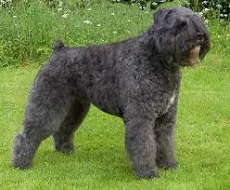Alternative Names: koes hond (cow dog), toucheur de boeuf (cattle drover), vuilbaard (dirty beard)
Country of Origin: Belgium

History: The Bouvier des Flandres was developed in the Flanders area of Belgium as a cattle dog, used for both herding and driving. It is believed to be descended from Continental herding breeds, such as the schnauzer. Its use was antiquated when the automobile was invented and cattle began being transported by truck; however, breed fanciers worked to save the breed. Although it is no longer used for herding or driving, it has worked as a police and military dog, guide dog, and search and rescue dog. The breed was first introduced to the U.S. in the 1930s.
Physical Description: This is a large, powerful, squarely built, compact dog with a large head. The flat skull is long and broad with a broad muzzle. It has oval, brown eyes; a large, black nose; and small ears that cropped erect or naturally drop. The neck is muscular and chest is broad. The Bouvier des Flandres is naturally tailless or the tail is docked to about four inches long and set high. The double coat has a fine, dense undercoat and rough, tousled outer coat with a thick mustache, beard, and eyebrows with erect hairs. The coat is short on the skull and upper part of the back. It may be fawn, gray, brindle, salt and pepper, or black. Some have a small, white star on the chest.
Height: 23.5 to 27.5 inches
Weight: 65 to 100 pounds
Temperament: This is a versatile dog that is even-tempered and gentle. It is protective but capable of determining real from imagined threats. It is both courageous and intelligent and does fine with children,
Activity Level: High
Best Owner: An active, dog-experienced owner in a rural or suburban home is best.
Special Needs: Fenced yard, grooming, positive training, socialization
Possible Health Concerns: Autoimmune disorders, cancer, glaucoma, hip and elbow dysplasia, hypothyroidism, subaortic stenosis




